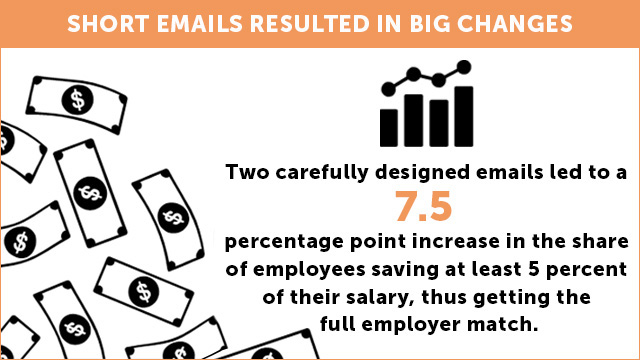To get better results from some of its programs, the U.S. Department of Labor (DOL) assembled an expert study team to design and rigorously test the impacts of behavioral science interventions on three DOL programs. The team’s findings reveal strong positive impacts on all three programs.
1. Behavioral insights increased retirement savings by DOL employees.
Roughly one in four DOL employees contributed less than 5 percent of their salary to the agency’s retirement savings program in 2015. Hoping to increase their savings, DOL commissioned a study to determine whether inexpensive behavioral interventions that were easy to implement could increase employees’ contributions to their retirement savings. The study team, which included experts from Mathematica and ideas42, tested the effectiveness of a pair of simple emails designed to overcome behavioral barriers to saving. The emails featured graphics to help people visualize their future selves, and prompted employees to “act now” by taking five simple steps. The study results revealed that this email led to a 7.5 percentage point increase in the share of employees who save at least 5 percent of their salary.
2. Incorporating behavioral insights helped more employers resolve Occupational Safety and Health Administration (OSHA) citations.
OSHA was concerned because not many employers were successfully resolving their safety citations by removing workplace hazards and paying the necessary penalties. The study team tested whether a modified citation process based on behavioral science could lead to more resolutions. This process included a revised cover letter strategically designed to address behavioral roadblocks such as procrastination and information overload. The revised citation process led to a 4.4 percentage point reduction in the number of employers referred to debt collection for failing to resolve their case.
3. Behavioral insights increased take-up of Michigan reemployment programs.
When fewer than half of those eligible to participate in the MichiganWorks! Reemployment and Eligibility Assessment (REA) program actually scheduled their first REA session, the study team developed simple, inexpensive emails informed by behavioral science to raise the rate of participation in the program. These encouraging emails resulted in a 15 percentage point increase in the proportion of UI claimants who scheduled their first REA session. There was also a 14 percentage point increase in the proportion of UI claimants who completed the REA program.
This work was conducted for DOL’s Chief Evaluation Office as part of the project, Behavioral Interventions for Labor-Related Programs, which was designed to explore the potential of using insights from behavioral economics, psychology, and related fields to improve the performance and outcomes of DOL programs. To build practitioners’ and policymakers’ capacity to apply behavioral insights, the project team drew on lessons learned from this project, as well as from other behavioral experiments, to develop these helpful resources:
- Behavioral Insights Communications Checklist
- Quick Steps to Improve Programs Using Behavioral Insights
- Practitioner’s Playbook for Applying Behavioral Insights to Labor Programs
- Implementation Brief on Using Behavioral Insights to Strengthen Labor Programs: Lessons Learned
- Podcast on Lessons Learned from the Department of Labor’s Behavioral Interventions Project
Download the Podcast
Learn more about behavioral insights and Mathematica’s work with DOL at Behavioral Interventions for Labor-Related Programs.

